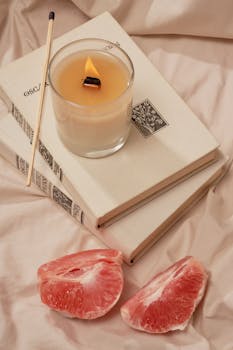As an Amazon Services LLC Associates Program participant, we earn advertising fees by linking to Amazon, at no extra cost to you.
How to remove glue stick residue from fabric
Here are some effective ways to remove glue stick residue from fabric without damaging the material:
- Apply ice cubes directly on the residue to harden it, then scrape off as much as possible with a blunt knife or spoon.
- Mix warm water and mild soap to create a gentle cleaning solution. Dab the affected area with the solution using a clean cloth or sponge.
- For tougher residue, try using rubbing alcohol or nail polish remover. Test in an inconspicuous area first to ensure it does not damage the fabric.
- If the fabric is washable, launder it according to the care instructions after removing the residue to fully clean the area.
- For delicate fabrics like silk or wool, it’s best to seek professional dry cleaning to avoid any damage.
Step-By-Step Guide for Applying Glue Stick on Fabric
Learn how to effectively apply a glue stick on fabric with this detailed guide. Perfect for all your arts and crafts projects!
- Choose the Right Type of Glue Stick: Make sure you have a glue stick specifically designed for fabric.
- Prepare the Fabric: Ensure the fabric is clean and free of any dust or debris before applying the glue stick.
- Test on a Small Area: Before applying the glue stick to the entire fabric, test it on a small, inconspicuous area to ensure compatibility.
- Apply the Glue Stick: Gently apply the glue stick to the desired area of the fabric, using even pressure for a smooth application.
- Allow to Dry: Let the glue stick dry completely before proceeding with your project to ensure a strong bond.
- Heat Set (if necessary): Some glue sticks may require heat setting for a more secure hold. Follow the manufacturer’s instructions for best results.
Common Mistakes to Avoid When Using Glue Stick on Fabric
Using a glue stick on fabric can be a convenient way to work on arts and crafts projects, but it’s crucial to be mindful of certain mistakes that can easily occur. One common error is not testing the glue stick on a small, inconspicuous area of the fabric first. This simple step can help prevent any damage or discoloration to the fabric. Another mistake to steer clear of is using too much glue, as this can lead to a messy and uneven application. It’s important to apply the glue stick in thin, even layers for the best results.
Additionally, be sure to let the glue dry completely before moving or manipulating the fabric to avoid any shifting or warping of the material. Lastly, avoid using a glue stick on delicate or sheer fabrics that may not be able to withstand the adhesive. By being mindful of these common mistakes, you can ensure that your glue stick projects on fabric turn out beautifully and long-lasting.
Fabric Glue Stick with Refill. Specially formulated for fabrics, this tool is simple to use without the hassle of pin holes. the glue applies yellow and then …
Best Practices for Using Hot Glue Sticks with Fabric We are often asked, "Can glue guns be used on fabric?" The simple answer is yes but you will need to …
Picture of 43239 ALEENE'S DIY CRAFT INDUSTRIAL GLUE STICKS 2PK. SHOP NOW … Custom Weekend Travel Bag with Super Fabric Adhesive. Real reviews from real …
This high strength adhesive dries crystal clear and can be used on a variety of surfaces, making it the perfect alternative to a traditional needle and thread.
Mar 9, 2019 … (Use a white pencil if the fabric is dark). Place an applique piece as shown above. Tack in place with the glue stick. My latest pattern …
Creative Projects Using Glue Stick on Fabric
Looking to add a unique touch to your fabric projects? Get ready to explore the exciting world of using glue stick on fabric! Whether you’re a seasoned crafter or just starting out, this adhesive tool can open up a whole new realm of possibilities. From creating intricate designs to bonding embellishments securely, the possibilities are endless.
With just a simple glue stick in hand, you can elevate your fabric creations to a whole new level. Experiment with different fabrics, textures, and colors to bring your visions to life. Whether you’re making custom clothing, home decor accents, or personalized gifts, the versatility of glue stick on fabric is unmatched.
Join us on this creative journey as we dive into inspiring projects, step-by-step tutorials, and tips for maximizing the potential of your glue stick. Unleash your artistic potential and let your imagination soar!
Choosing the Right Glue Stick for Fabric
When it comes to crafting with fabric, choosing the right glue stick is essential for a successful project. As an avid crafter, I have tried and tested various glue sticks and have found that not all are created equal. For fabric projects, it’s crucial to select a glue stick specifically designed for this material to ensure a strong bond. Opting for a multi-purpose glue stick may result in a weak adhesion that can ruin your creation.
Before starting your project, make sure to read the label and confirm that the glue stick is suitable for fabric. Investing in a quality fabric glue stick may seem like a small detail, but it can make a significant difference in the longevity and durability of your crafts. Trust me, the right glue stick can elevate your fabric projects to the next level!
Alternative Options to Glue Stick for Fabric
Fabric projects require a reliable adhesive to ensure your creations stay together for the long haul. While glue sticks are a popular choice for many crafters, there are alternative options worth exploring. Fabric glue, for example, offers a stronger bond and dries clear, making it ideal for a wide range of projects. Fusible webbing is another great alternative, allowing you to bond fabrics together with a simple ironing process. For a more versatile option, try fabric tape, which offers ease of use and a mess-free application. If you’re looking for a temporary solution, fabric spray adhesive can provide a temporary hold without damaging your materials. Experiment with these alternatives to find the perfect adhesive for your next fabric masterpiece!
Cleaning and Maintenance of Fabric Glue
Fabric glue is a crucial tool for any arts and crafts enthusiast. Ensuring its proper cleaning and maintenance is essential for longevity and optimal performance. To start, always cap the glue tightly after each use to prevent air exposure, which can lead to drying out. For spills or residues on the bottle or cap, wipe them off immediately with a damp cloth. When dealing with dried glue on fabric surfaces, gently scrape off as much as possible before applying a solvent like acetone or nail polish remover. It’s important to test the solvent on a small, inconspicuous area first to ensure it won’t damage the fabric. Lastly, store your fabric glue in a cool, dry place away from direct sunlight or heat sources to prevent deterioration. By following these simple maintenance tips, you can keep your fabric glue in top condition for all your creative projects.
Best practices for securing fabric with glue stick
When it comes to securing fabric with a glue stick, I have found that following these best practices can make a world of difference. From experience, I can confidently say that these tips will help you achieve a strong and long-lasting bond.
- Choose the right type of glue stick: Not all glue sticks are created equal. Make sure to select a glue stick that is specifically designed for fabric.
- Prepare the fabric: Before applying the glue stick, ensure that the fabric is clean and free of any debris. This will help the glue adhere better.
- Apply the glue sparingly: Less is more when it comes to using a glue stick on fabric. Apply a thin, even layer to prevent any excess glue from seeping through.
- Press firmly: Once you have applied the glue stick to the fabric, be sure to press firmly to ensure a strong bond. You can use a roller or your fingers to apply pressure.
- Allow time to dry: Give the glue stick enough time to dry and set before moving or handling the fabric. This will help prevent the bond from weakening.
Benefits of using glue stick for fabric projects
When working on fabric projects, using a glue stick can be incredibly helpful. Here are some reasons why:
- Mess-free application: Glue sticks are easy to use and don’t create a mess like liquid glue.
- Quick drying time: Unlike some adhesives, glue sticks dry quickly, allowing you to continue working without waiting.
- No stains: Glue sticks often dry clear, meaning you won’t have to worry about unsightly stains on your fabric.
- Convenient to carry: Glue sticks are compact and portable, making them ideal for crafting on the go.
- Versatile: Glue sticks can be used for a variety of fabric projects, from hemming to applique.
Tips for Applying Glue Stick on Fabric
When using a glue stick on fabric, it is important to follow these tips to ensure a successful outcome:
– Make sure the fabric is clean and free of any dirt or debris before applying the glue stick.
– Apply the glue stick in a thin, even layer to prevent clumping or uneven adhesion.
– Press the fabric together firmly after applying the glue stick to ensure a strong bond.
– Allow the glue stick to dry completely before handling or washing the fabric.
– Always test the glue stick on a small, inconspicuous area of the fabric before applying it to the entire surface.
By following these tips, you can effectively use a glue stick on fabric for your arts and crafts projects.
Supplies Needed for Glue Stick on Fabric Projects
When it comes to creating stunning fabric projects using glue sticks, having the right supplies is essential. Here are the must-have items to ensure your creations turn out beautifully.
- Fabric: Choose your favorite fabric to serve as the base for your project.
- Glue Stick: Opt for a high-quality glue stick specifically designed for fabric to ensure a strong bond.
- Scissors: A sharp pair of scissors is essential for cutting fabric to the desired shape and size.
- Embellishments: Get creative with beads, sequins, and other embellishments to add a unique touch to your project.
- Templates: Consider using templates or stencils to create precise shapes and designs on fabric.
- Paints: If you want to add color to your fabric project, make sure to have fabric paints on hand.
- Brushes: Different brushes can help you apply paint or glue with precision.
- Protective Covering: To avoid any mess, lay down a protective covering on your work surface while working on your fabric project.
- Inspiration: Don’t forget to bring your creativity and inspiration to the table to make your fabric project truly unique.
Exploring Different Types of Fabric Glue
Fabric glue can be a game-changer when it comes to crafting projects. As an avid crafter myself, I have tried and tested various types of fabric glue to find the perfect one for each project. From liquid adhesives to glue sticks and spray adhesives, each type has its own strengths and weaknesses.
Liquid fabric glue is versatile and great for precision work, while glue sticks are convenient for quick fixes. Spray adhesives can cover a larger area evenly, making them ideal for large-scale projects.
Experimenting with different types of fabric glue is essential to find what works best for you. Consider the type of material you are working with and the desired durability of the bond before making a decision. Don’t be afraid to mix and match different types of fabric glue to achieve the perfect results for your arts and crafts projects.
Is glue stick suitable for all types of fabric?
Glue sticks are not suitable for all types of fabric. While they may work well with light fabrics such as cotton or polyester, they can leave residue and damage delicate fabrics like silk or satin. For best results, always test a small hidden area before using a glue stick on fabric. Consider using fabric glue specifically designed for different fabric types for a more secure and long-lasting bond.
Can glue stick be washed after application on fabric?
**No, glue stick should not be washed after application on fabric.** Once a glue stick is applied to fabric, it is not meant to be washed or laundered. The adhesive properties of the glue stick may not hold up well to washing and could cause damage to the fabric. It is best to avoid washing fabric with glue stick applied to it to ensure the longevity and integrity of the project.
How long does glue stick take to dry on fabric?
Glue sticks typically take about 1-2 hours to dry on fabric. It’s important to let it dry completely before moving or washing the fabric. Avoid touching the glued area until it’s fully dried to prevent smudging or messing up the bond. It’s best to follow the manufacturer’s instructions for specific drying times. Once the glue is dry, your fabric project will be ready to display or use!
Can glue stick damage fabric over time?
Absolutely! While glue sticks are convenient for quick craft projects, they can be detrimental to fabrics in the long run. The chemicals in glue sticks can weaken the fibers of the fabric over time, leading to potential damage such as discoloration, stiffness, or even tearing. It’s important to use fabric-friendly adhesives like fabric glue or sewing for projects involving fabric to ensure longevity and durability.
Are there any fabric types that are not suitable for glue stick?
Yes, some fabric types are not suitable for glue stick. Fabrics with a very loose weave or delicate texture may not adhere well with glue stick. Additionally, fabrics that are water-resistant or have a silicone coating may also pose challenges when using glue stick. It’s best to test a small area before proceeding with the project to ensure that the glue stick will work effectively on the fabric.
Can glue stick on fabric be used for outdoor projects?
Glue stick on fabric may not be the best choice for outdoor projects due to its limited durability in outdoor conditions. Exposure to sunlight, moisture, and temperature changes can weaken the adhesive bond, causing the project to come apart. For long-lasting results, consider using a specialized outdoor fabric adhesive that is designed to withstand outdoor elements.
Glue stick can be a convenient choice for temporary fabric projects. When working on quick crafts or repairs, its ease of use and clean application make it a handy tool in your artistic arsenal.
Always test the glue stick on a small, inconspicuous area of the fabric first to prevent any damage or discoloration before applying it to your entire project. It’s a simple step that can save you from a crafting disaster.
Make sure to follow manufacturer instructions for best results when working on your arts and crafts projects. This ensures safety and success in your creative endeavors.
For more permanent projects, fabric adhesive is my go-to choice. It ensures a strong bond that lasts, perfect for creating long-lasting crafts.
As an Amazon Services LLC Associates Program participant, we earn advertising fees by linking to Amazon, at no extra cost to you.



